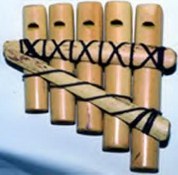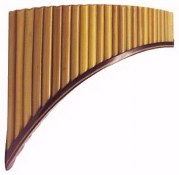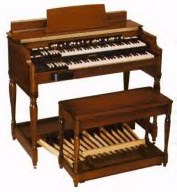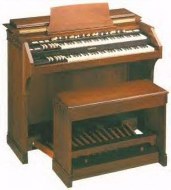Pipe Organ 101 (sort of) | Our Philosophy of Organ Tuning | The Physics of the Organ | How an Organ is tuned | Harmoniums and Reed Organs | Carillons | Harpsichords
 |
 |
"Wow... that's a really BIG piano...!"
If we had a dime for every time we heard someone say that when looking at an organ console... we'd have enough... well, let's just say that I'd have enough to buy a few bags of potato chips for the kind folks who staff the UniRes office! And those dimes? Well, they're appropriate - because this is definitely a ten-cent tour!
Every academician, early in his/her career is issued a stern warning against defining things negatively -
Now having said that... I'm gonna do it anyway, and you can e-mail me your academic censure later:
AN ORGAN IS NOT A BIG PIANO. IT'S NOT A SMALL PIANO. IT'S NOT ANY KIND OF PIANO AT ALL!
Yes, both instruments have manual keyboards with black and white keys, though on very old organs, or copies of old organs, the "black keys" are often white, and vice versa. (Why is that? You ask... Frankly, it has mostly to do with the price of ivory vs. the price of rosewood or ebony. I wish there were a better answer. There isn't.)
The organ and piano are "philosophically antithetical". That is just a hyper-articulate way of saying that they are played and operate like opposites. (We find saying things like "hyper-articulate" and "philosophically antithetical" are good ways to impress people at parties - but then we might be going to really boring parties!)
Strike a key on a piano.
No matter how hard you strike the key... it's over almost before it's begun. (We know that sounds depressing, but it is the truth!) The sound begins to fade away as soon as the hammer hits the wire. Press an organ key and the sound will continue for as long as the key is held - until there is a power failure, or in the case of antique instruments, until the bellows operator takes his hand off the pump because he is holding up a frayed copy of the bellows pump operator's union regulations.
For an instrument to be an organ, it must be able to sustain tones at a steady volume and pitch indefinitely. It must also be able to sustain several tones at once.
So the thunderous instruments that inhabit the galleries of the great houses of worship are organs. So are the melodeon in your great aunt's parlor and the electronic "mini-keyboard" you purchased for your nephew last Christmas.
Just a little bit of history - ten-cents worth, to be precise: The organ's earliest antecedent is the so-called "pan pipes" - a very ancient instrument composed of graduated tubes that are bound together. The panpipes allow the player to play several notes simultaneously, and play them for as long as the player has breath.
We didn't mean to sound pejorative towards the piano. We were just stating a truth of physics. The law of inertia, to be specific.
It is that decay of tone, which is one of the things that pianists strive to overcome, and that they ultimately use to their artistic advantage. The "benefit" of the organ's capacity to indefinitely sustain tone is one of the great stumbling blocks in playing the instrument musically.
And it is related directly to the next unhappy truism of all "true" organs:
There is no way to directly control the volume (loudness or softness of the sound.)
Most instruments essentially become an extension of the player's body. Players of wind instruments and string instruments and percussion instruments all have very direct control over the sound they are creating. Even the pianist can summon loud tones by playing "harder" and more dulcet ones by playing "softer."
The organ, however, is a machine.
One plays a key - or a whole fistful of them if you prefer - and the organ, electrically or otherwise, takes over. As if to add insult to injury, in modern pipe organs the console may be dozens if not hundreds of feet from the pipe work - the part that actually produces the sound.
Yes, we can control volume and tone color. But these things are done mechanically - by opening swell shutters, or drawing different combinations, or by revoicing chords, or by articulation - the amount of space a player leaves between successive notes. All artificial means. But therein lies the artistry in playing the organ.
Here are a few terms that it might be helpful to know when talking about organs:
Manual as a musical term means keyboard - as in organ keyboard.
If you're "in the business" you never refer to a pipe organ as a "three keyboard" pipe organ. It's always a "three manual" pipe organ. If you ask someone "how many keyboards does that organ have?" they will look at you like you don't have a clue. If you ask, "How many manuals does that organ have, you are 'in the know'..."
Pedals or Pedal board refers to the "keyboard" that the organist manipulates with his/her feet. Pedal can also refer to devices called "swell pedals" or "crescendo pedals" which are implements for controlling the volume of sound.
We generally refer to instruments by the number of manuals, and pedal board. For example, a typical church pipe organ of average size has two manuals and a pedal board. If the organ was built by Austin Organ Co. then the organ is referred to as a Two Manual and Pedal Austin. Abbreviated 2M/P Austin.
Sometimes you will see organ specifications abbreviated like this:
An 85 rank, four manual Moller organs becomes - Moller, IV/85. In this kind of abbreviation the number of manuals is always in Roman numerals. It is typically assumed that a modern pipe organ has a pedal board.
By the way, very, very few organs have more than one pedal board... the handful that do - well, that was (in our opinion, at least) the builder doing something simply because he could... it really is highly impractical, and even creates basic design problems. I've never seen a multiple pedal board instrument with a satisfactory design, and no one has ever been able to justify any other reason for doing such a thing other than what I just stated - BUT THAT'S JUST MY OPINION!
Console size does not actually determine the size of the instrument - theater pipe organs often have 3, 4, 5 or even 6 manuals but are seldom more than 25 -30 ranks, typical being closer to 10-15, on the other hand, one can find 2 M/P church organs with 70 ranks of pipes.
A lot of this has to do with HOW the instrument will be played - what kind of music it is intended for, and the ideology of the builder.
We personally believe that a good musician can find the inspiration to make good music on any number of different types of instruments, and that variety, in music, as in life, adds spice. Guess that's why we are Universal.
Note: For a (much) fuller, more detailed, and definitely more scholarly explanation of what an organ is and the history of the instrument, we heartily recommend the article in Grove's Dictionary of Music and Musicians. If you'd like a resource that you can actually pick up and take with you, as opposed to one that needs a flat bed trailer to haul around, please write to us and we'd be only too happy to suggest some other excellent reading. Seriously.
|
 |
 |
About Us | The Mandeville Organ | The Morey Organ | The Never Ending Project | The Essex Chapel Project | Anything Can Be Fixed | Products And Services | Links | Contact Us | Guest Book